Discover 35 hidden attractions, cool sights, and unusual things to do in Shanghai (China). Don't miss out on these must-see attractions: Shanghai Museum, Shanghai Urban Planning Exhibition Center, and Oriental Pearl Tower. Also, be sure to include China Art Museum in your itinerary.
Below, you can find the list of the most amazing places you should visit in Shanghai (Shanghai).
Table of Contents
Shanghai Museum
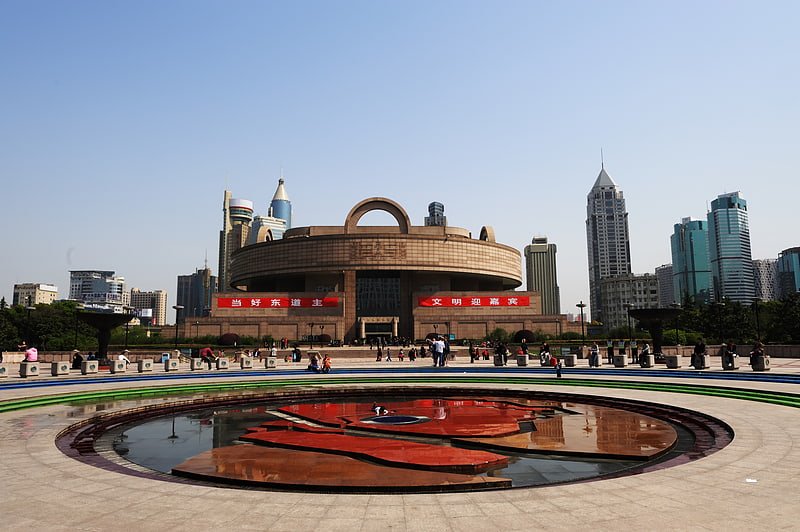
Also known as: 上海博物馆
Museum in Shanghai, China. The Shanghai Museum is a museum of ancient Chinese art, situated on the People's Square in the Huangpu District of Shanghai, China. Rebuilt at its current location in 1996, it is considered one of China's first world-class modern museums.[1]
Address: 201 Renmin Ave, 200003 Huangpu (黄埔)
Shanghai Urban Planning Exhibition Center
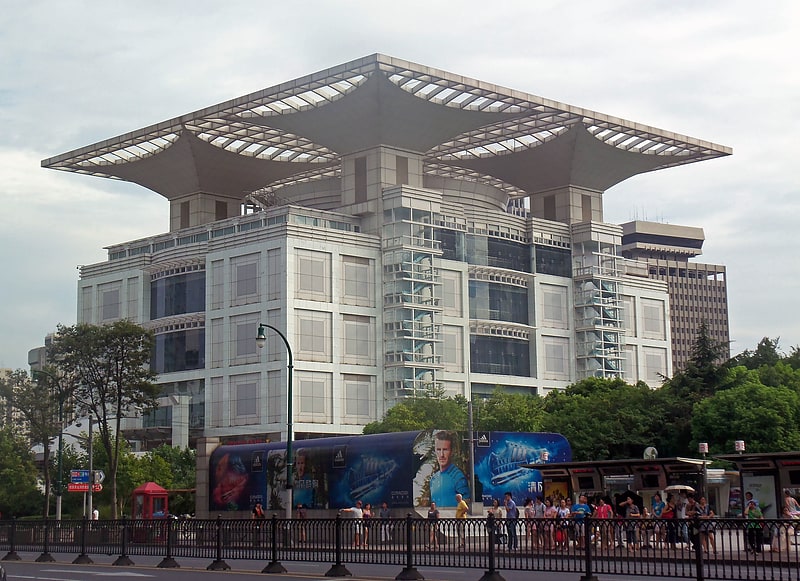
Also known as: 上海城市规划展示馆
Venue for urban-development exhibits. The Shanghai Urban Planning Exhibition Center is located on People's Square, Shanghai, adjacent to the municipal government building.
The Exhibition Center is a six-story building, with two basement levels, which displays Shanghai's urban planning and development. The focus of the exhibit is a large scale model of the entirety of urban Shanghai, showing existing buildings and approved future buildings. Other exhibits relate to Shanghai's history and planned development, including smaller scaled models focussing on particular areas of interest such as the Bund. The Exhibition Center also has space for temporary exhibitions with a wide range of subject matter.[2]
Address: 100 Renmin Ave, 200051 Huangpu Qu (黄埔)
Oriental Pearl Tower
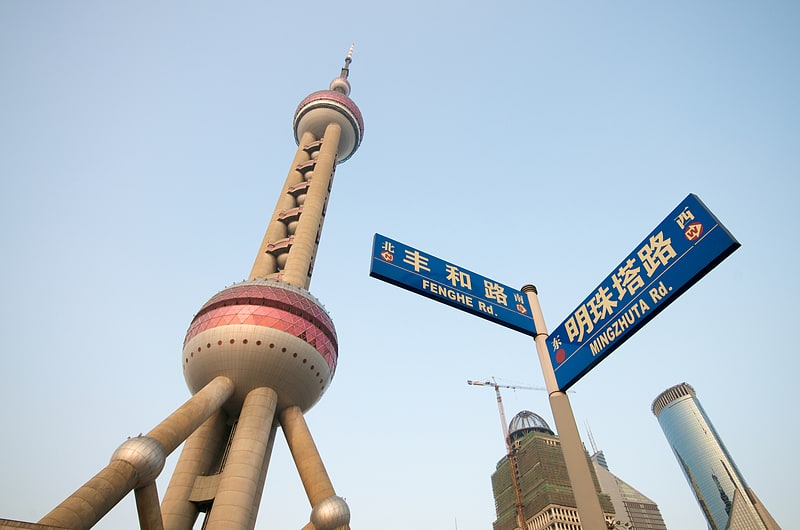
Also known as: 东方明珠广播电视塔
Iconic tower with city views. The Oriental Pearl Radio & Television Tower is a TV tower in Shanghai. Its location at the tip of Lujiazui in the Pudong New Area by the side of Huangpu River, opposite The Bund, makes it a distinct landmark in the area. Its principal designers were Jiang Huan Chen, Lin Benlin, and Zhang Xiulin. Construction began in 1991, and the tower was completed in 1994.
At 468 m (1,536 feet) high, it was the tallest structure in China from 1994–2007, when it was surpassed by the Shanghai World Financial Center. It is classified as an AAAAA scenic area by the China National Tourism Administration. The tower is brightly lit in different LED sequences at night. On 7 July 2007, Oriental Pearl Tower was host to the Chinese Live Earth concert.
The tower features 11 spheres, big and small. The two largest spheres, along the length of the tower, have diameters of 50 m (164 ft) for the lower and 45 m (148 ft) for the upper. They are linked by three columns, each 9 m (30 ft) in diameter. The highest sphere is 14 m (46 ft) in diameter.
In 1995, the Oriental Pearl TV Tower was rated as one of the top ten new landscapes in Shanghai. In 1999, the Oriental Pearl TV Tower won the first prize of Shanghai Excellent Survey and Design Award and the Zhan Tianyou Award of China Civil Engineering. On May 8, 2007, the Oriental Pearl TV Tower was approved by the National Tourism Administration as a national AAAAA-level tourist attraction.
The entire tower is supported by three enormous columns that start underground.[3]
Address: 1 Century Ave, 200088 Pudong Xinqu (浦东)
China Art Museum

Also known as: 中华艺术宫
Museum in Shanghai, China. The China Art Museum, also called the China Art Palace or its original name, Shanghai Art Museum, is a museum of modern Chinese art located in Pudong, Shanghai. The museum is housed in the former China Pavilion of Expo 2010. It is one of the largest art museums in Asia.[4]
Address: 205 Shangnan Rd, Shanghai (浦东)
The Bund
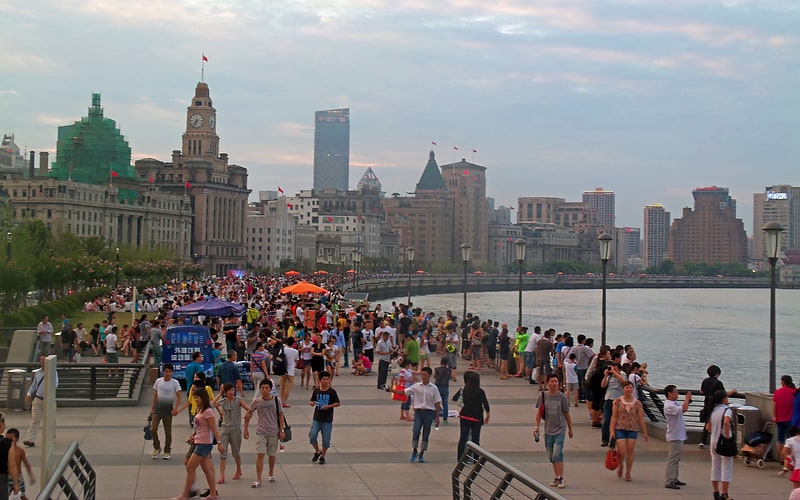
Also known as: 外滩
Famed waterside walkway with city views. The Bund or Waitan is a waterfront area and a protected historical district in central Shanghai. The area centers on a section of Zhongshan Road within the former Shanghai International Settlement, which runs along the western bank of the Huangpu River in the eastern part of Huangpu District. The area along the river faces the modern skyscrapers of Lujiazui in the Pudong District. The Bund usually refers to the buildings and wharves on this section of the road, as well as some adjacent areas. From the 1860s to the 1930s, it was the rich and powerful center of the foreign establishment in Shanghai, operating as a legally protected treaty port.[5]
Address: Zhongshan East 1st Rd, 200051 Huangpu Qu (黄埔)
Yu Garden
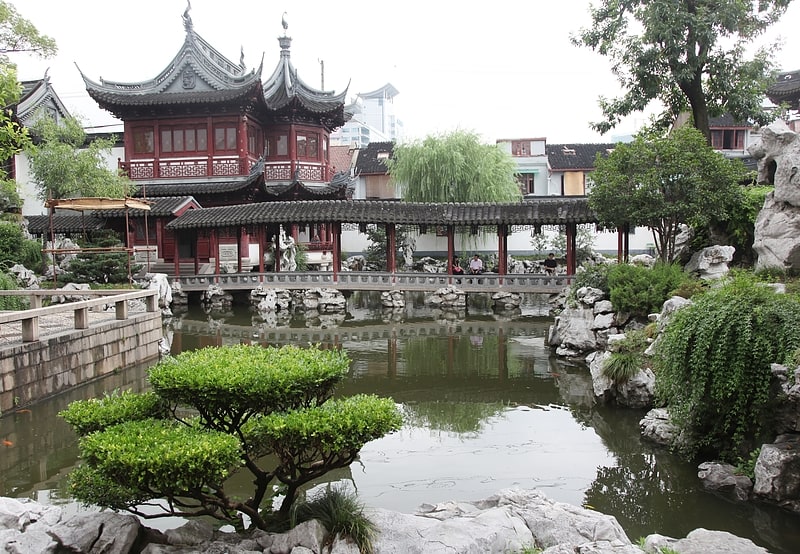
Also known as: 豫园
Winding, famed classical garden. Yu Garden or Yuyuan Garden is an extensive Chinese garden located beside the City God Temple in the northeast of the Old City of Shanghai at Huangpu District, Shanghai. It abuts the Yuyuan Tourist Mart, the Huxinting Teahouse and the Yu Garden Bazaar.
This garden is accessible from the Shanghai Metro's Line 10 and Line 14 Yuyuan Garden station.
A centerpiece is the Exquisite Jade Rock a porous 3.3-m, 5-ton boulder. Rumours about its origin include the story that it was meant for the Huizong Emperor at the imperial palace in Beijing, but was salvaged from the Huangpu River after the boat carrying it had sunk.[6]
Address: 218 Anren St, 200088 Huangpu Qu (黄埔)
Shanghai World Financial Center

Also known as: 上海环球金融中心
Soaring skyscraper with dining and views. The Shanghai World Financial Center is a supertall skyscraper located in the Pudong district of Shanghai. It was designed by Kohn Pedersen Fox and developed by the Mori Building Company, with Leslie E. Robertson Associates as its structural engineer and China State Construction Engineering Corp and Shanghai Construction General Co. as its main contractor. It is a mixed-use skyscraper, consisting of offices, hotels, conference rooms, observation decks, and ground-floor shopping malls. Park Hyatt Shanghai is the tower's hotel component, comprising 174 rooms and suites occupying the 79th to the 93rd floors, which at the time of completion was the highest hotel in the world. It is now the third-highest hotel in the world after the Ritz-Carlton, Hong Kong, which occupies floors 102 to 118 of the International Commerce Centre.
On 14 September 2007, the skyscraper was topped out at 492 meters (1,614.2 ft), making it the 2nd tallest building in the world on completion (the tallest at the time being Taipei 101), and the tallest building in Mainland China. The SWFC opened to the public on 28 August 2008, with its observation deck opening on 30 August. The observation deck offers views from 474 m (1,555 ft) above ground level.
The SWFC has been lauded for its design, and in 2008 it was named by architects as the year's best-completed skyscraper. In 2013, the SWFC was exceeded in height by the adjacent Shanghai Tower, which is China's tallest structure as of 2021. Together, The Shanghai World Financial Center, The Shanghai Tower and The Jin Mao Tower form the world's first adjacent grouping of three supertall skyscrapers.[7]
Address: 100 Century Ave | 世纪大道100号, 200120 浦东 (浦东)
Shanghai Zoo
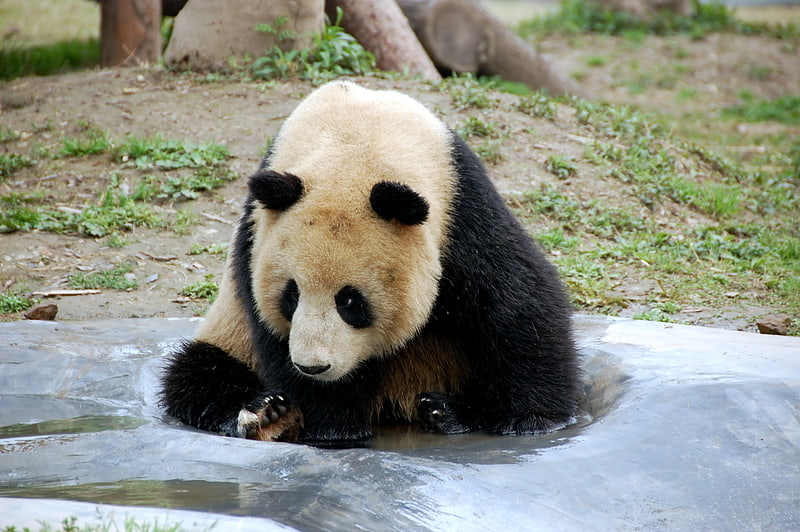
Also known as: 上海动物园
Zoological garden in Shanghai, China. Shanghai Zoological Park, or commonly Shanghai Zoo in short, is the main zoological garden in Shanghai. It is located near the township of Hongqiao and is administratively in Changning District. Shanghai Zoo was formerly known as " Xijiao Park", which is still a common name used locally for the zoo.[8]
Address: 2381 Hongqiao Rd, Shanghai (长宁)
Jinjiang Action Park
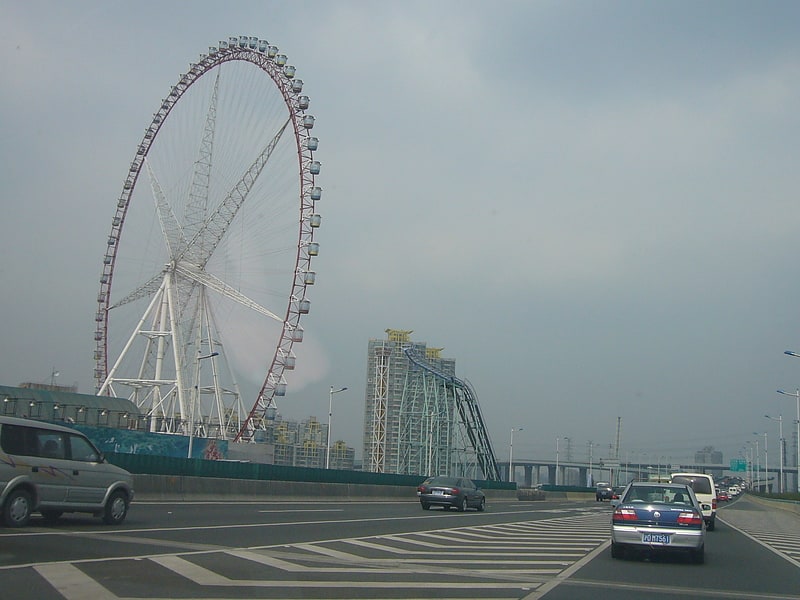
Also known as: 锦江乐园
Amusement park in Shanghai, China. Jinjiang Action Park is a large amusement park at No. 201 Hongmei Road in Xuhui District, Shanghai. Founded in 1984, it is affiliated to the Jinjiang Group.[9]
Address: 201 Hongmei Rd, Shanghai (闵行区)
Shanghai History Museum
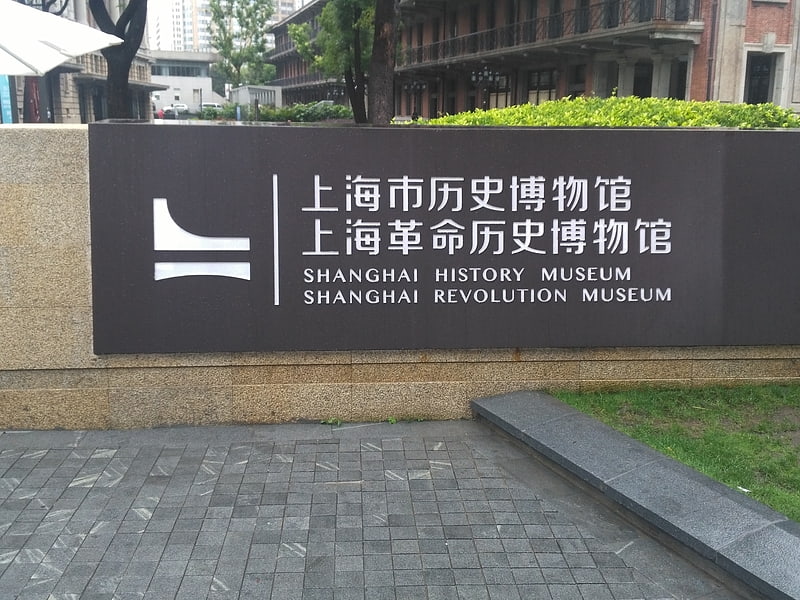
Also known as: 上海市历史博物馆
Museum in Shanghai, China. The Shanghai History Museum, or Shanghai Revolution History Museum, is a museum dedicated to the history of the city of Shanghai, China.
The museum's collections focus on the approximately a hundred years in the history of Shanghai from the opening of the port in 1843 to the communist take-over in 1949. The museum's oldest relics are from 6,000 years ago. It features a cannon used in the first Opium War, a sedan chair, and two bronze lions that used to adorn the Hongkong and Shanghai Banking Corporation on the Bund. Other exhibits reveal the history of art, culture and industrialization in Shanghai. The neo-classical Shanghai Race Club building that houses the museum, has an imposing 10-storey tall tower which was long a landmark of central Shanghai.[10]
Address: 193 Hankou Road, Shanghai (浦东)
Jing'an Temple
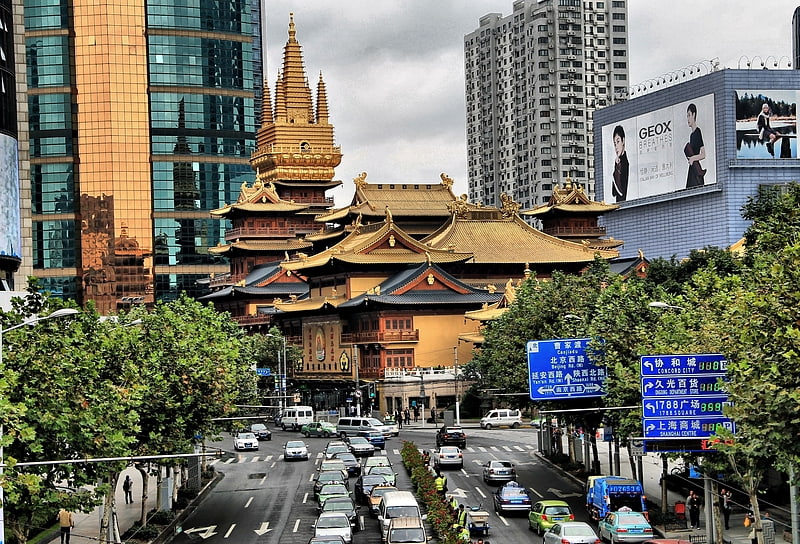
Also known as: 静安寺
Historic Buddhist temple complex. Jing'an Temple is an esoteric Tangmi Buddhist temple on the West Nanjing Road in Shanghai. Jing'an District, where it is located, is named after the temple.[11]
Address: 1686 Nanjing W Rd | 南京西路1686号, 200040 Jingan (静安)
Chenxiang Pavilion
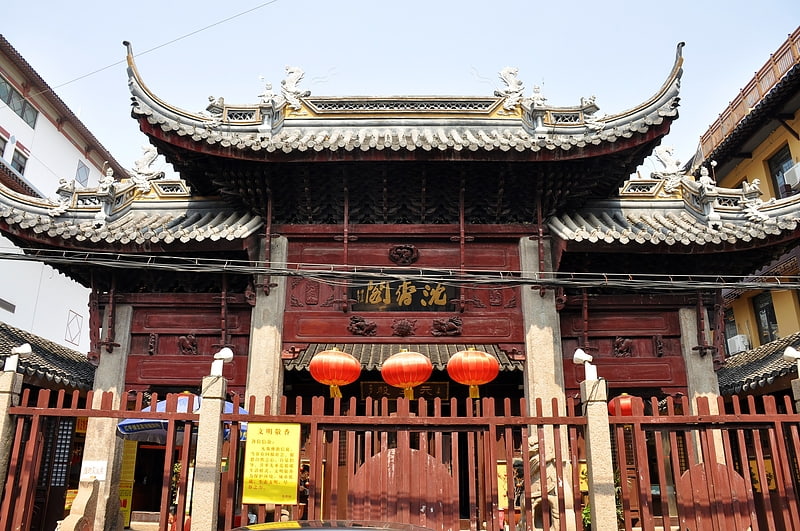
Chenxiang Pavilion or Chenxiangge Nunnery is a Buddhist temple located in the Huangpu District of Shanghai. Now it is a Bhikkhuni temple.[12]
Address: 338 Fuyou Road, Shanghai (黄埔)
Site of the First National Congress of the Chinese Communist Party
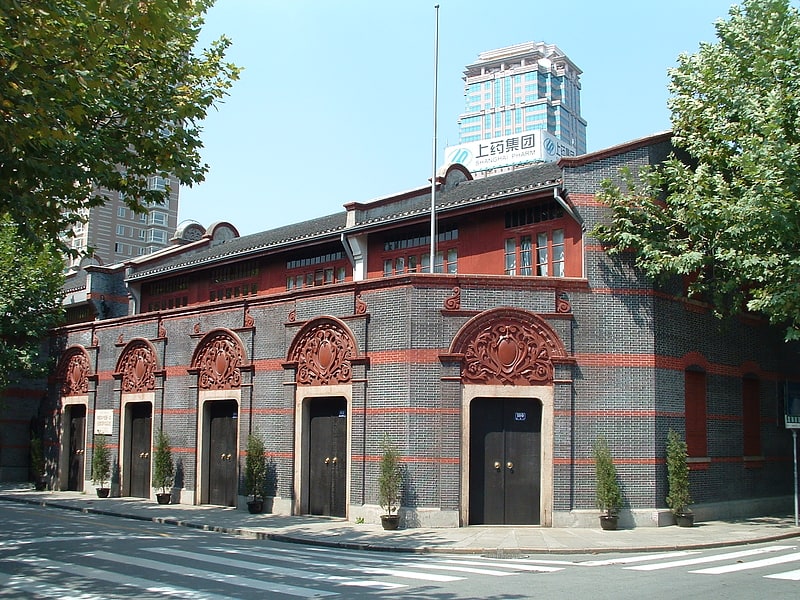
Also known as: 中国共产党第一次全国代表大会会址
Museum. The Site of the First National Congress of the Chinese Communist Party is now preserved as a museum in Shanghai, China. It is located in Xintiandi, on Xingye Road. It is located in the historical shikumen buildings in which the 1st National Congress of the Chinese Communist Party took place during the month of July in 1921.
The museum combines exhibits about the history of China, the history of the city of Shanghai, and the events surrounding the foundation of the Chinese Communist Party.[13]
Jade Buddha Temple
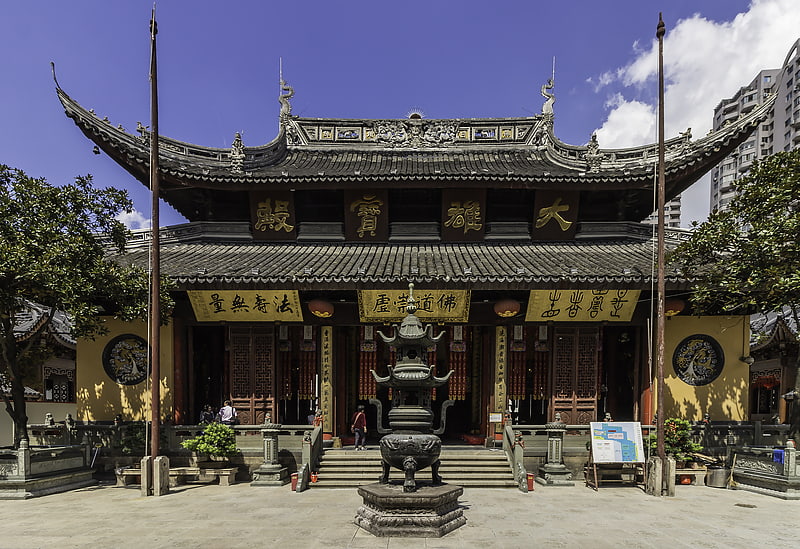
Also known as: 玉佛寺
Monastery with many sculptures. The Jade Buddha Temple is a Buddhist temple in Shanghai. It was founded in 1882 with two jade Buddha statues imported to Shanghai from Myanmar by sea. These were a sitting Buddha, and a smaller reclining Buddha representing the Buddha's death. The temple now also contains a much larger reclining Buddha made of marble, donated from Singapore, and visitors may mistake this larger sculpture for the original, smaller piece.
The legend behind the transport of the Buddha statues from Myanmar led to the popular usage of Burmese-style Buddha statues in Chinese temples.[14]
Shanghai Science and Technology Museum

Also known as: 上海科技馆
Museum in Shanghai, China. Shanghai Science and Technology Museum is a large museum in Pudong, Shanghai, close to Century Park, the largest park within the inner districts of the city. It is one of China's most-visited museums. It received 1,351,000 visitors in 2020, despite a fall of attendance of 72 percent from 2019 due to restrictions and reduced tourism imposed by the COVID-19 pandemic.[15]
Address: 世纪大道2000号 | 2000 Century Ave., Shanghai (浦东)
Waibaidu Bridge
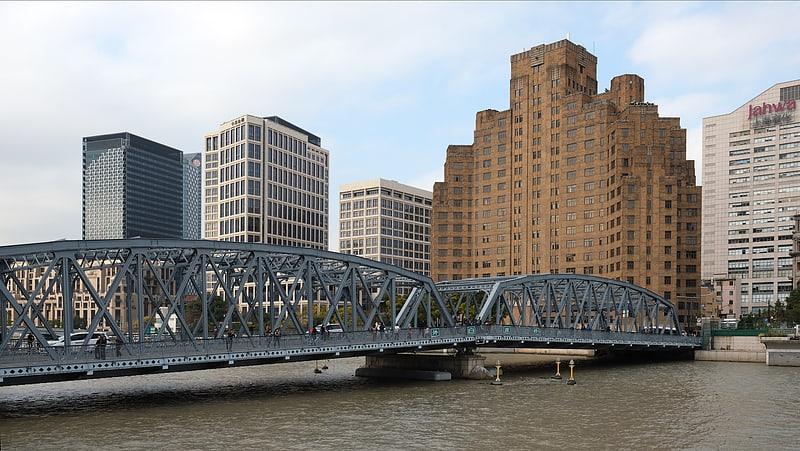
Also known as: 外白渡桥
Iconic all-steel bridge with LED lights. The Waibaidu Bridge, called the Garden Bridge in English, is the first all-steel bridge, and the only surviving example of a camelback truss bridge, in China. The present bridge is the fourth Western-designed bridge built at its location since 1856, in the downstream of the estuary of the Suzhou Creek, near its confluence with the Huangpu River, adjacent to the Bund in central Shanghai. It connects the Huangpu and Hongkou districts and was opened on 20 January 1908. With its rich history and unique design the Waibaidu Bridge is one of the symbols of Shanghai. Its modern and industrial image may be regarded as the city's landmark bridge. On 15 February 1994 the Shanghai Municipal Government declared the bridge an example of Heritage Architecture, and one of the outstanding structures in Shanghai. In an ever-changing metropolis, the Waibaidu Bridge still remains a popular attraction, and one of the few constants in the city skyline.[16]
Aurora Plaza
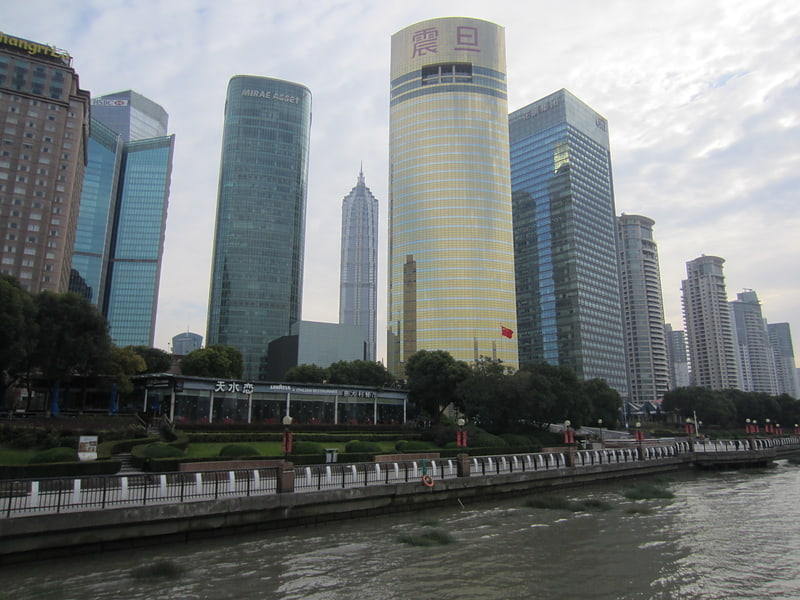
Also known as: 震旦国际大楼
Skyscraper in Shanghai, China. Aurora Plaza is a 185 m high skyscraper in the Pudong financial district, Lujiazui, of Shanghai, China, that was completed in 2003. It is one of the more recognisable of the smaller towers in the Pudong skyline, due to its curved sleek facade, its former large "AURORA" logo and a large video screen projected onto the front of the building at night.[17]
Zhenru Temple
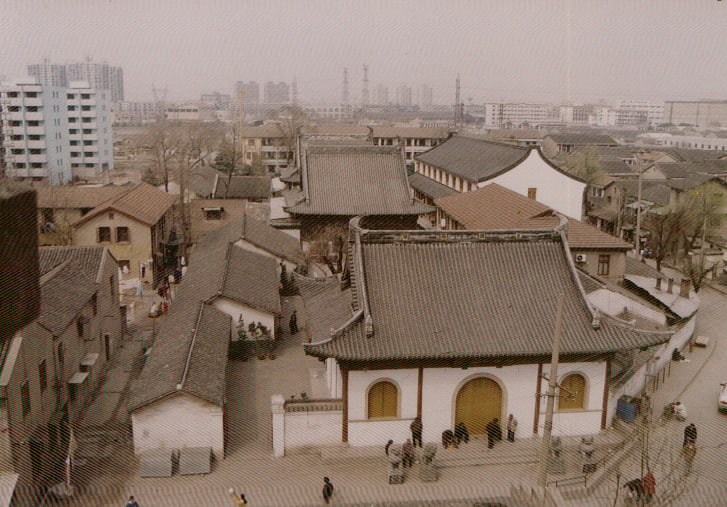
Temple in Shanghai, China. Zhenru Temple is a Buddhist temple located in Putuo District of Shanghai, China. It is a Major National Historical and Cultural Site in Shanghai.[18]
Address: 399 Lanxi Road, Shanghai (普陀)
50 Moganshan Road
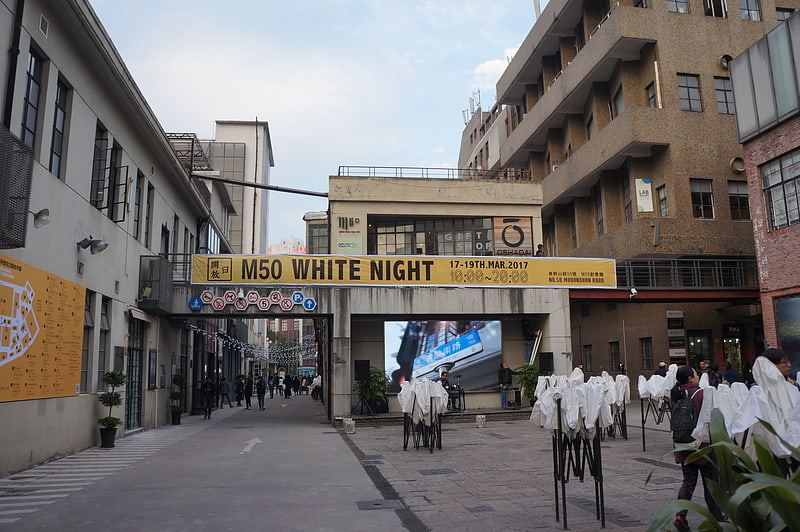
Also known as: M50创意园
Entertainment in Shanghai, China. 50 Moganshan Road or "M50" is a contemporary art district in Shanghai, China, that houses a community of more than a hundred artists whose studios are open to the public. It is often compared with New York's SoHo and Beijing's 798 Art Zone. The art quarter has become a popular cultural attraction for local and international visitors alike, and was named among the top ten things to do in Shanghai by Time Magazine.[19]
Address: 50 Moganshan Road, Shanghai (闸北)
General Post Office Building
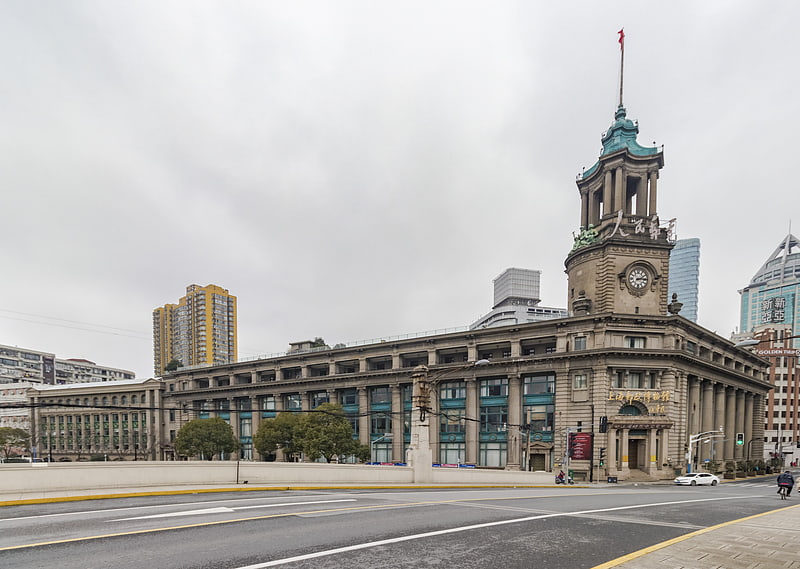
Also known as: 上海邮政总局
Post office in Shanghai. The General Post Office Building is the head post office of Shanghai, China. Built in 1924, the four-storey building is located at 395 Tiandong Road, at the north end of the Sichuan Road Bridge, on the banks of the Suzhou Creek.[20]
Address: No.276 Suzhou Road, Sichuan Road, 200080 Shanghai (虹口)
Huangpu Park
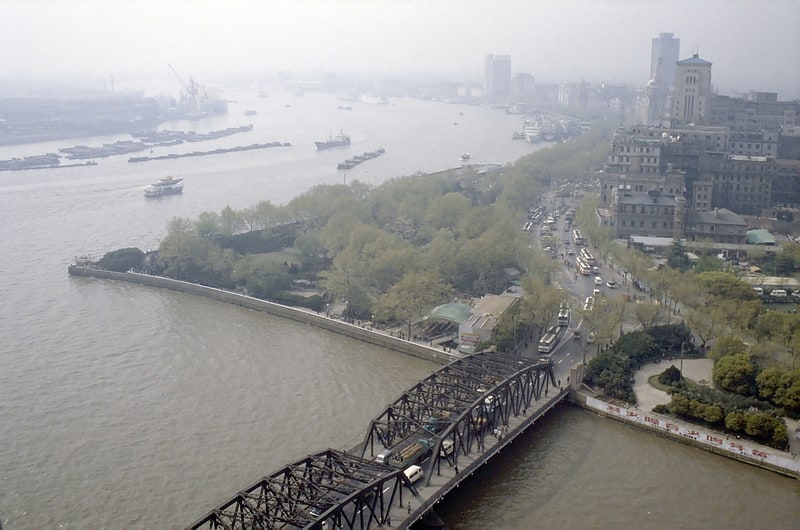
Also known as: 黃浦公園
19th-century European-style park. Huangpu Park is the name of the triangular stretch of green at the northern end of the Bund in Shanghai, the oldest and smallest park of the city. It is the site of the large Monument to the People's Heroes, commemorating those who helped to free China from foreign occupation, and of the Bund Historical Museum, which documents the history of the Bund in old photographs.[21]
St. Ignatius Cathedral

Also known as: 徐家汇圣依纳爵主教座堂
Roman Catholic church from early 1900s. St. Ignatius Cathedral, also known as the Xujiahui Cathedral or the Xujiahui Catholic Church, is a Roman Catholic cathedral, located in Xujiahui, Shanghai, China. Since 1960, St Ignatius has been the seat of the Bishop of Shanghai and the headquarters of the Roman Catholic Diocese of Shanghai. It was designed in the Neo-Gothic style by William Doyle and built between 1906 and 1910.[22]
City God Temple of Shanghai
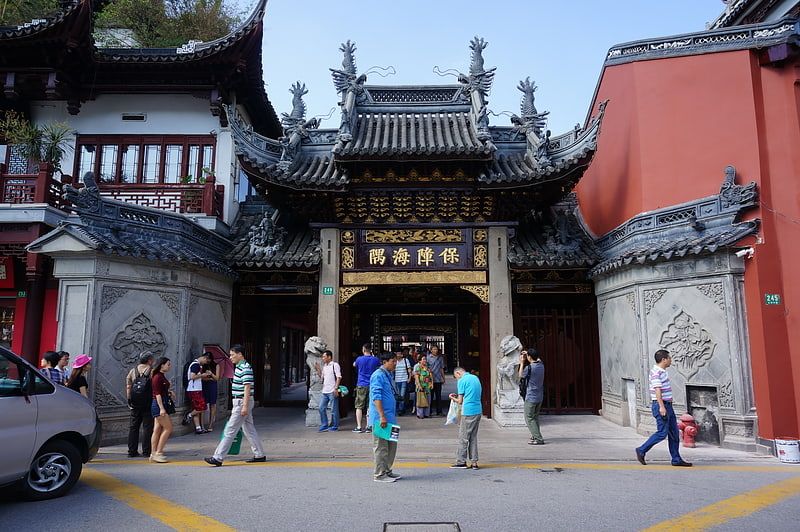
Also known as: 上海城隍廟
Expansive historic temple complex. The City God Temple or Temple of the City Gods, officially the City Temple of Shanghai, is a folk temple located in the old city of Shanghai. It commemorates the elevation of Shanghai to municipal status and is the site of the veneration of three Chinese figures honored as the city gods of the town. It is also known by some locals as the "Old City God Temple", in reference to a later "New City God Temple" which no longer exists.[23]
Address: 249 Fangbang M Rd, Shanghai (黄埔)
Guilin Park
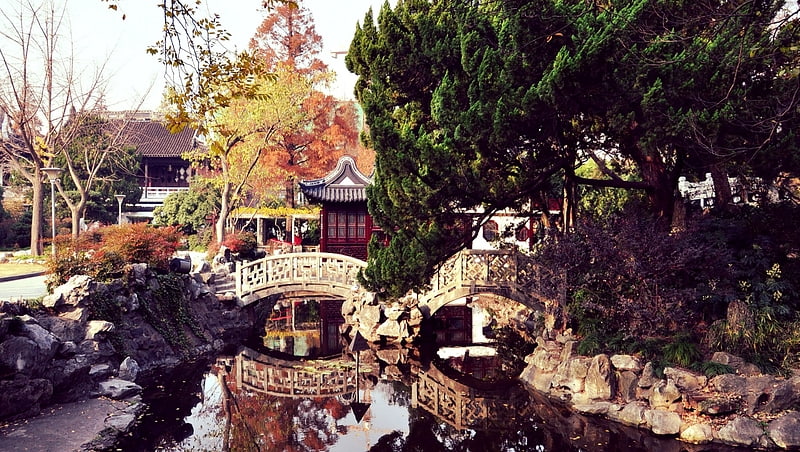
Park in Shanghai, China. Guilin Park is a public park in Shanghai, China. It is located at the homonymous metro station on line 12 and line 15.[24]
Address: 188 Caobao Lu, Shanghai (徐汇)
Shanghai Ocean Aquarium
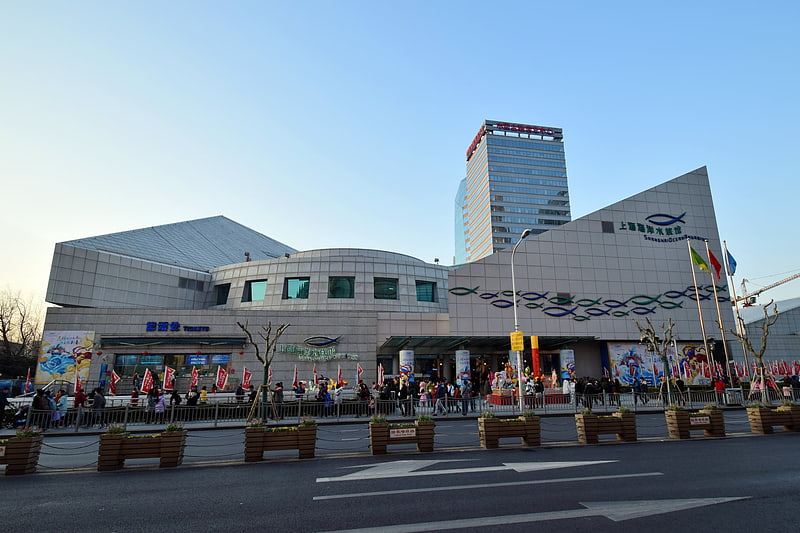
Also known as: 上海海洋水族馆
Aquarium in Shanghai, China. The Shanghai Ocean Aquarium is a public aquarium located in Shanghai, China.
Designed by Advanced Aquarium Technologies, the aquarium includes a 168-meter (551 ft) tunnel that takes visitors through a coastal reef, open ocean, a kelp cave, shark cove, and a coral reef, and is one of the longest such tunnels in the world. The aquarium takes visitors through several exhibit "zones," including China Zone, South America Zone, Africa Zone, etc.[25]
Address: 1388 Lujiazui Ring Rd, 200120 浦东 (浦东)
People's Park

Also known as: 上海人民公园
Park in Shanghai, China. People's Park is a public park in Huangpu District of central Shanghai. It is located south of Nanjing Road, a major shopping street, and north of People's Square. Originally the northern part of the Shanghai Race Club's race course, the park was created in 1952. With several major museums and Shanghai's main shopping street nearby, it is one of the top tourist destinations in the city.[26]
Address: 231 Nanjing W Rd, Shanghai (黄埔)
Xujiahui Park
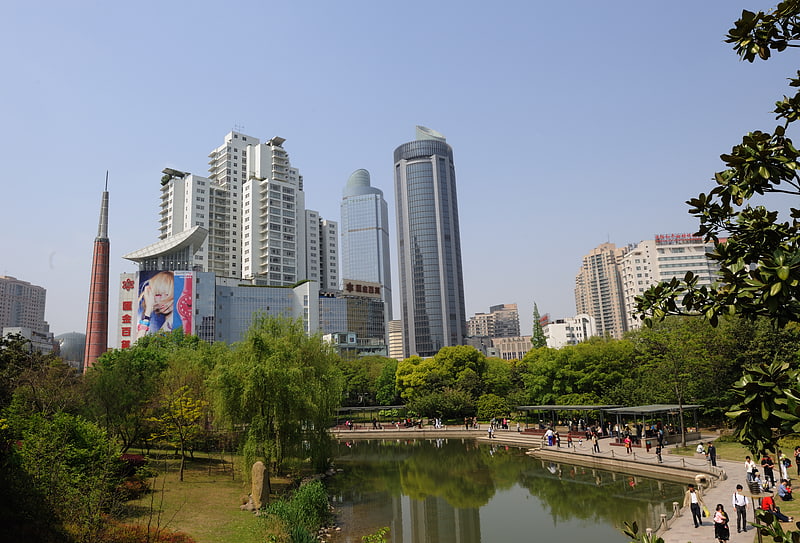
Xujiahui Park is a park in Xuhui District, Shanghai. It was built in 1999, on the former grounds of the Great Chinese Rubber Works Factory and the EMI Recording Studio. The park has an artificial lake with a sky bridge running across the park.[27]
Shanghai Film Museum
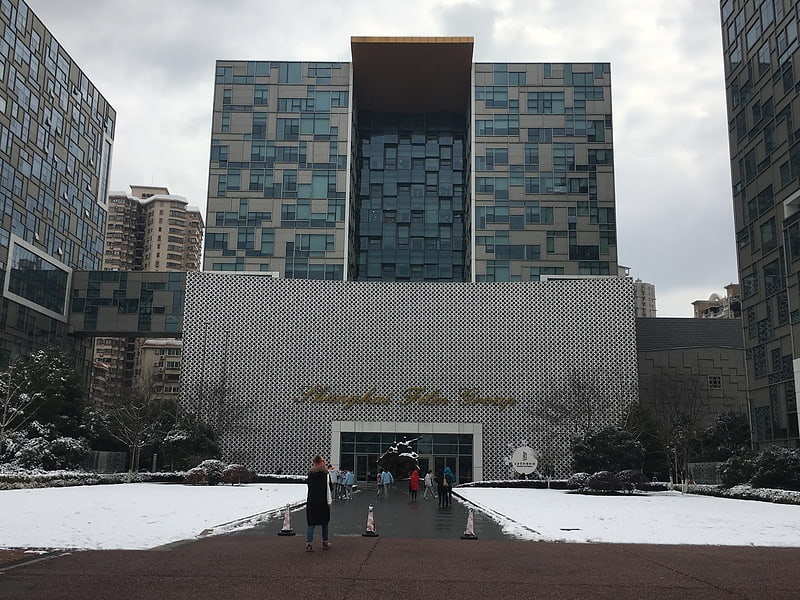
The Shanghai Film Museum is a museum in Shanghai, China, located at 595 North Caoxi Road in Xuhui District. The exhibition area is 15,000 square meters. Combining interaction, observation and experience, Shanghai Film Museum possesses many functions like film culture activities, historical relic collection, academic research, social education, and exhibitions. The museum contains 4 main exhibition units and an art cinema.[28]
Address: North Caoxi Road 595, Shanghai (徐汇)
Shanghai Grand Theatre
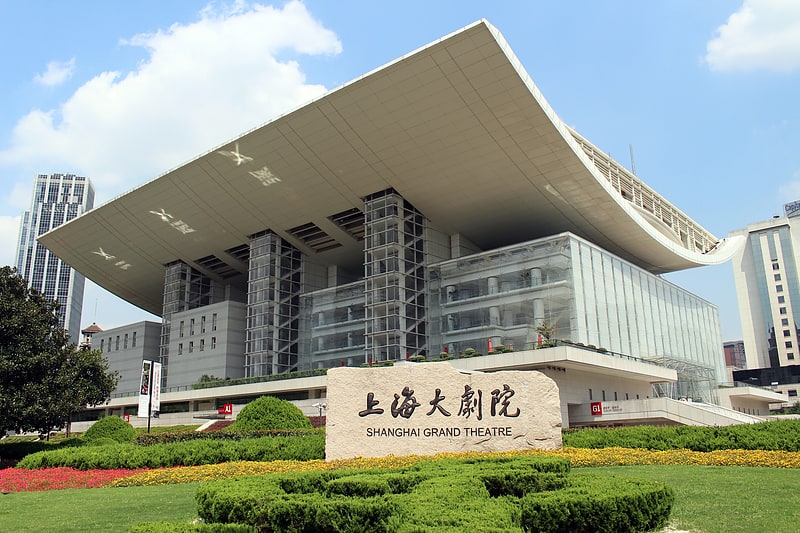
Also known as: 上海大剧院
Theater in Shanghai, China. The Shanghai Grand Theater is one of the largest and best-equipped automatic stages in the world. Since the theater opened on August 27, 1998, it has staged over 6,000 performances of operas, musicals, ballets, symphonies, chamber music concerts, spoken dramas and various Chinese operas. The site is located at the intersection of Central Boulevard and Huangpi Road South in the northern part of the People's Square in Huangpu District, Shanghai. It is the home of the Shanghai Opera House Company; however, the title "Shanghai Opera House" officially applies to only the performing company and not to the building. The Shanghai Grand Theater is also the resident for other performing companies.[29]
Longhua Temple
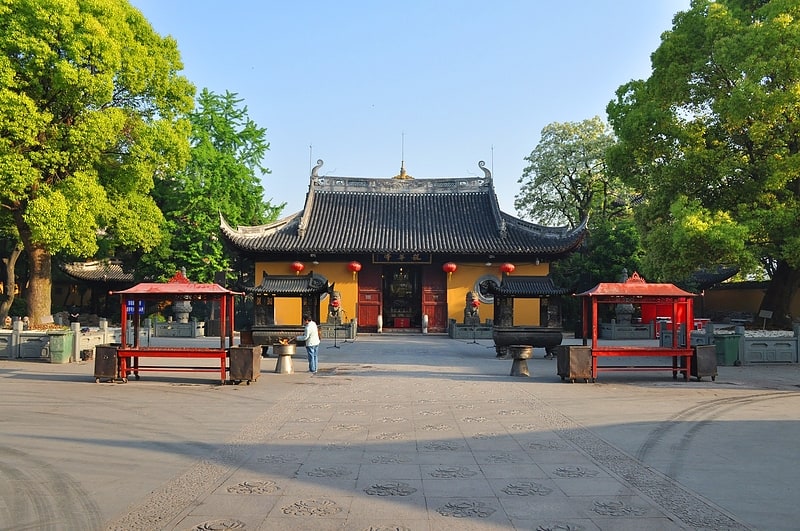
Also known as: 龙华寺
Reconstructed Buddhist temple complex. The Longhua Temple is a Buddhist temple dedicated to the Maitreya Buddha in Shanghai. Although most of the present day buildings date from later reconstructions, the temple preserves the architectural design of a Song dynasty monastery of the Chan School. It is the largest, most authentic and complete ancient temple complex in the city of Shanghai.[30]
Address: 2853 Longhua Rd | 龙华路2853号, Shanghai (徐汇)
Lu Xun Park

Also known as: 鲁迅公园
Recreational area with a notable grave. Lu Xun Park, formerly Hongkou Park, is a municipal park in Hongkou District of Shanghai, China. It is located on 146 East Jiangwan Road, right behind Hongkou Football Stadium. It is bounded by Guangzhong Road to the north, Ouyang Road to the northeast, Tian'ai Road to the southeast, Tian'ai Branch Road to the south, and East Jiangwan Road to the west. The park is named after the Chinese writer Lu Xun, who lived nearby in the last years of his life, and is the location of the tomb of Lu Xun and the Lu Xun Museum. In 1932, Korean nationalist Yun Bong-gil detonated a bomb at the park, killing or injuring several high-ranking figures of the Imperial Japanese military during a celebration of Emperor Hirohito's birthday.
Lu Xun Park is just north of Duolun Road, a historic street that is now a car-free zone. It is also located near Lu Xun's former residence, a three-story Japanese-style home where the author lived from 1933 until his death in 1936.[31]
Address: 146 Dongjiangwan Rd | 东江湾路146号, 200081 Hongkou (虹口)
Jin Mao Tower

Also known as: 金茂大厦
Soaring skyscraper with scenic views. The Jin Mao Tower, also known as the Jinmao Building or Jinmao Tower, is a 420.5-meter-tall, 88-story landmark skyscraper in Lujiazui, Pudong, Shanghai, China. It contains a shopping mall, offices and the Grand Hyatt Shanghai hotel which starts from the 53rd floor, which at the time of completion was the highest hotel in the world. Along with the Oriental Pearl Tower, the Shanghai World Financial Center and the Shanghai Tower it is part of the Lujiazui skyline seen from the Bund. It was the tallest building in China from its completion in 1999 until 2007, when it was surpassed by the Shanghai World Financial Center which is located close by. The Shanghai Tower, a 128-story building located next to these two buildings, surpassed the height of both these buildings in 2015, creating the world's first trio of adjacent supertall skyscrapers.[32]
Address: 88号 Century Ave, Pudong, Shanghái, República Popular China, Shanghai (浦东)
Power Station of Art

Also known as: 上海当代艺术博物馆
Museum in Shanghai, China. The Power Station of Art is a contemporary art museum in Shanghai. Housed in a former power station, it is China's first state-run contemporary art museum. Converting the building cost $64 million which was paid for by the Shanghai government.
The museum is on the site of the Expo 2010 and on the left bank of the Huangpu River. It opened in 2012 with an exhibition of contemporary art from Centre Pompidou, Paris's best-known contemporary art museum, entitled Electric Fields, Surrealism and Beyond.
The director is Li Xu. The deputy director is Gong Yan, who was formerly the editor in chief of the Chinese-language magazine Art World.[33]
Address: 200 Huayuangang Rd, Shanghai (黄埔)
Lupu Bridge

Also known as: 卢浦大桥
Through arch bridge in Shanghai, China. The Lupu Bridge, named after Luwan District, is a through arch bridge over the Huangpu River in Shanghai, China, connecting the city's Huangpu and Pudong districts. It is the world's third longest steel arch bridge, after the Ping'nan Third Bridge in Guangxi and the Chaotianmen Bridge in Chongqing. The bridge has a total length including approach spans of 3,900 m and opened on June 28, 2003. The main bridge structure is 750m long including the two side spans of 100m each, and the main span of 550 metres over the Huangpu River is 32 metres longer than the previous record holder for the longest arch bridge, the New River Gorge Bridge in Fayetteville, West Virginia. It cost 2.5 billion yuan, including US$78.04 for the main steel structure alone. It is located adjacent to the former Expo 2010 site and served as the centrepiece of the world exposition in Shanghai.[34]
Address: Luban Road, Huangpu District, 200000 Shanghai (黄埔)
Fuyou Road Mosque
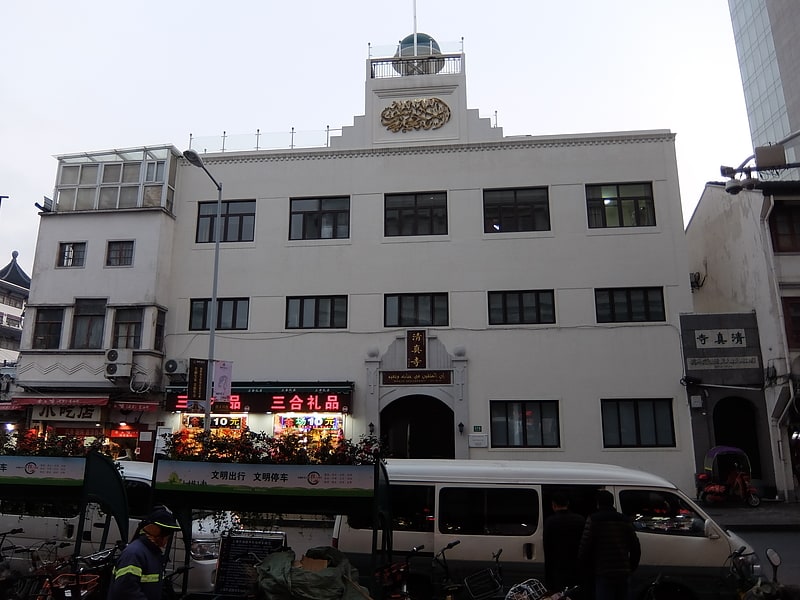
Also known as: 福佑路清真寺
Mosque in Shanghai, China. The Fuyou Road Mosque, also known as the North Mosque, is a mosque in Huangpu District, Shanghai, China.[35]